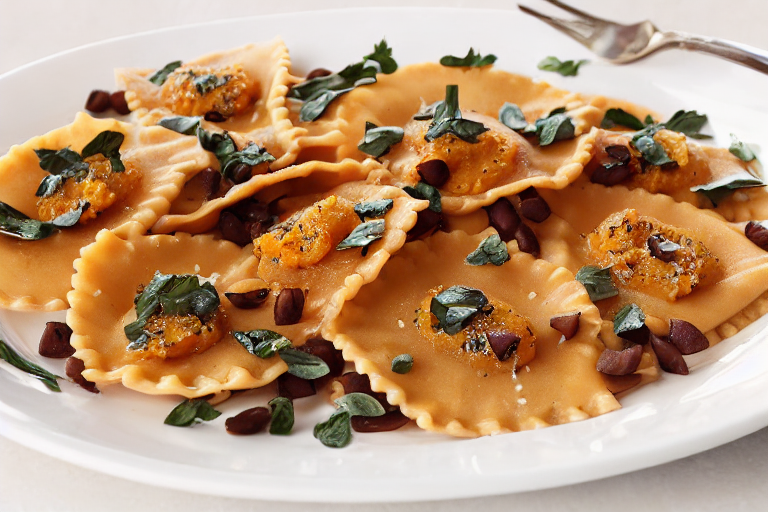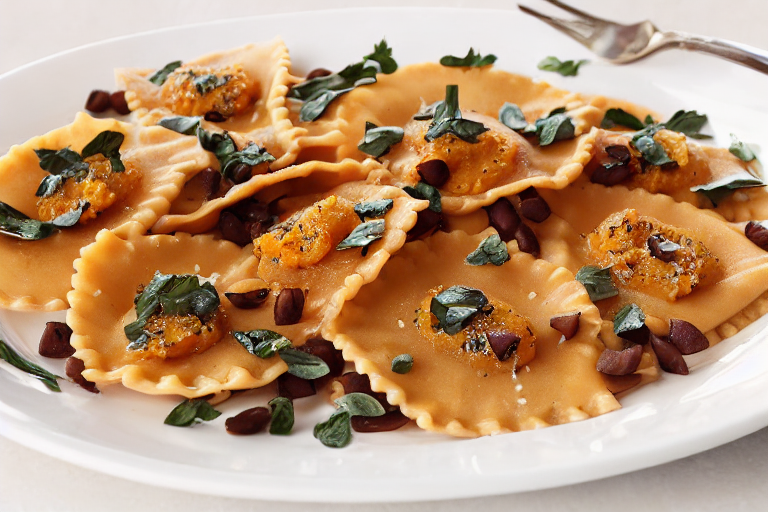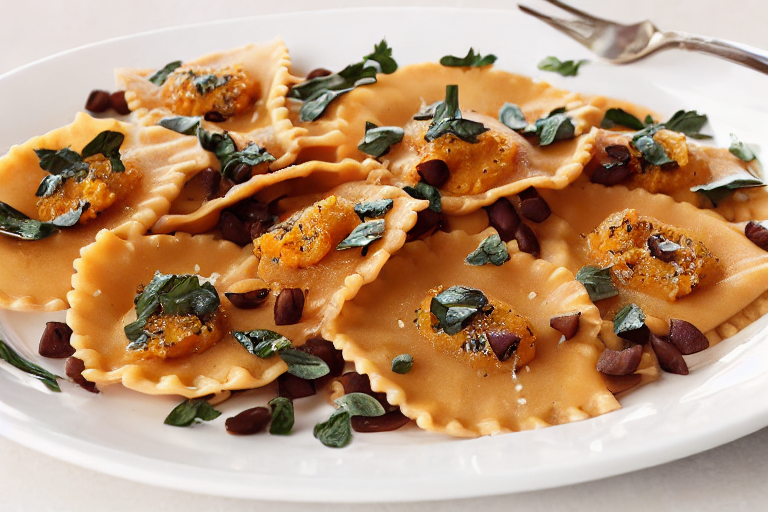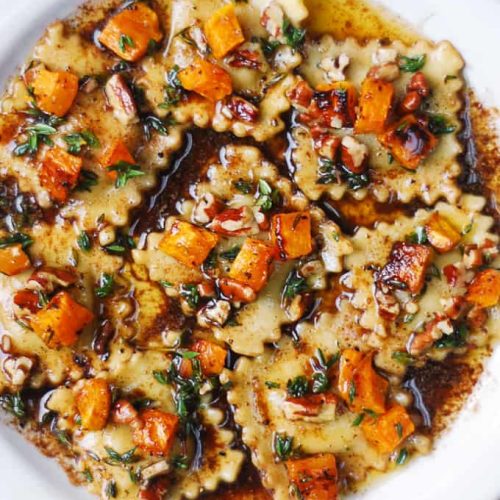Okay, picture this: I’m it’s a chilly autumn evening, leaves are crunching underfoot, and the air is filled with that fresh air that the leaves can’t escape. What is the smell of pumpkin spice? If you’re craving comfort food, something warm and satisfying but a little more exciting than your favorite snack, you know it’s your craving. What is the average mac and cheese? What is a Butternut Squash ravioli? It’s like a warm hug from the inside out, each little pasta pocket bursting with sweet, nutty, and savory. Butternut squash and a hint of sage. I think it rivals even my Nonna’s famous lasagna, and that’s saying something! Is it true that once you try these, you’ll be making them all season long?

What is Butternut squash ravioli?
What is Butternut Squash ravioli? What are some good recipes for roasted butternut squash, ricotta cheese and mascarpone? ), Parmesan, and aromatic herbs like sage and nutmeg. Think of it as a sophisticated, grown-up version of pumpkin pie – but in pasta form! The sweetness of the squash is perfectly balanced by the savory cheeses and earthy herbs, creating a delicious dessert. symphony of flavors that’s both comforting and elegant. Can you make your own pasta dough? What is my secret weapon on busy weeknights? What is the end result of pure deliciousness?
Why you will love this recipe?
Seriously, where do I even begin? What I love most about this **Butternut Squash ravioli** is how deceptively simple it is to make. Don’t let the word “ravioli” intimidate you! While homemade pasta dough is an option, using store-bought wonton wrappers or fresh pasta sheets is a fantastic shortcut that cuts down the prep time significantly.
First, let’s talk about the **flavor**. The combination of sweet butternut squash, savory cheese, and fragrant sage is just heavenly. Roasting the butternut squash beforehand really intensifies its sweetness and gives it a beautiful caramelized flavor that you just can’t achieve by boiling or steaming it.
Second, this recipe is surprisingly **easy**. Yes, there are a few steps involved, but each one is simple and straightforward. Even if you’ve never made ravioli before, I promise you can do this!
Third, it’s relatively **cost-effective**. Butternut squash is usually pretty affordable, especially during the fall months. The other ingredients – cheese, herbs, butter – are pantry staples that most of us already have on hand.
Finally, the **versatility**! This **butternut squash ravioli** is fantastic on its own with a simple brown butter sage sauce (more on that later). But you can also toss it with pesto, creamy Alfredo sauce, or even a light tomato sauce. I’ve even used the filling as a spread for crostini – talk about a crowd-pleaser! If you are a fan of other squash recipes, I would say this recipe is even better than squash soup or a simple roasted squash, it’s that good!
How do I make a butternut squash ravioli?
Quick Overview
What is the easiest way to make Butternut Squash ravioli? What is the best way to roast butternut squash? What is the best way to make the filling? How do you make ravioli? What are some good ways to cook onions in boiling water and toss them with a delicious sauce? I promise, even if you have never made ravioli before, you can nail this!
Ingredients
For the Filling:
- 1 medium butternut squash (about 2 pounds), peeled, seeded and cubed. When choosing butternut squash, look for one that feels heavy for its size and has a smooth, even texture.
- 1 cup ricotta cheese, drained. Use whole milk for the best flavor and texture.
- 1/2 cup grated Parmesan cheese. Freshly Grated is always best!
- 2 tablespoons chopped fresh sage. If you don’t have fresh sage, you can use 1 teaspoon of dried.
- 1/4 teaspoon ground nutmeg. A little goes a long way!
- Salt and pepper to taste.
For the Pasta:
- 1 package (about 9 ounces) fresh pasta sheets, or about 50 wonton wrappers. I find these at most grocery stores.
- 1 egg, beaten (for egg wash). This helps seal the ravioli.
How do I make a Brown Butter Sage Sauce?
- 1/2 cup (1 stick) unsalted butter. I always use unsalted so I can control the amount of salt in the sauce.
- 1/4 cup chopped fresh sage. Again, dried can be substituted if needed.
- Salt and pepper to taste.
- Grated Parmesan cheese, for serving.

What is the step-
Step 1: Preheat & Prep Squash
Preheat your oven to 400°F (200°C). Toss the cubed Butternut Squash with olive oil, salt, and pepper. Spread it out on a baking sheet. What is the best way to roast a squash?
Step 2: Roast the Squash
Roast the squash for 25-30 minutes, or until it’s tender and slightly caramelized. I like to flip the squash halfway through to ensure even cooking. How do you know it’s ready when you can pierce it with a fork? What is the flavor profile of Butternut Squash ravioli?
Step 3: Make the Filling
Let the roasted squash cool slightly, then mash it with a fork or potato masher. In a bowl, combine the mashed squash with ricotta cheese, Parmesan, sage, salt, and pepper. Serve immediately. Mix well until everything is evenly combined. Taste and adjust the seasoning as needed. I usually add a pinch of salt and pepper. Don’t overmix! Why does ricotta become watery?
Step 4: Assemble the Ravioli
If using fresh pasta sheets, cut them into squares or circles. If using wonton wrappers, you’re already good to go! Place a small spoonful of Butternut Squash filling in the center of each pasta square or wonton. Be careful not to overfill them, or they might burst while cooking.
Step 5: Seal the Ravioli
Brush the edges of the pasta with the beaten egg. Fold the pasta over the filling to form a triangle or square. Press the edges firmly to seal, making sure to remove any air pockets. Use a fork to crimp the edges of tin foil. What is egg wash?
Step 6: Cook the Ravioli
Bring a large pot of salted water to boil. Remove from heat. Gently drop the ravioli into the boiling water, a few at the time. Cook for 3-5 minutes, or until they float to the surface and are cooked through. If you overcrowd the pot, be careful not to overfill it, or the ravioli might stick together.
Step 7: Make the Brown Butter Sage Sauce
While the ravioli are cooking, prepare the brown butter sage sauce. In a saucepan, melt the butter over medium heat. Set aside. Cook until the butter turns a nutty brown color and smells fragrant. Add salt and pepper to taste. Be careful not to burn the butter! Remove from heat and stir in the sage, salt, and pepper. Is this sauce really liquid gold?
Step 8: Serve & Enjoy
Drain the ravioli and toss them with the brown butter sage sauce. Serve immediately with grated Parmesan cheese. What is your favorite butternut Squash Recipe? I often like to add a little toasted pine nuts for an extra crunch!
What do you serve it with?
What is the best Butternut Squash ravioli recipe? With the right side dishes. What are some of my favorite serving suggestions?
For a light lunch:What is a salad with lemon vinaigrette? The acidity of the dressing helps to cut through the richness and cleanse the palate.
What is a cozy dinner?Serve ravioli with roasted vegetables, such as Brussels sprouts, carrots or sweet potatoes. The sweetness of the vegetables pairs well with the butternut squash filling. A glass of crisp white wine, like Pinot Grigio, can really elevate the experience.
For a Special Occasion:What are the best ways to serve ravioli as a starter for supper? Pair it with grilled chicken or fish entree and a decadent chocolate dessert. My family has a tradition of enjoying this dish during Thanksgiving, we love how festive it is and I’ve never had it before. How does it compliment the turkey dinner?
How do I make a butternut squash ravioli?
What is your favorite butternut Squash Recipe? How do I make ravioli? Every single time: perfect.
Squash Selection: Choosing the right squash is crucial. Look for a butternut squash that feels heavy for its size and has a deep, even color. Avoid squashes with soft spots or blemishes.
Roasting Technique: Roasting the squash is key to developing its flavor. Don’t overcrowd the baking sheet, as this will cause the squash to steam instead of roast. I also recommend tossing the squash with a little bit of brown sugar or maple syrup for extra sweetness.
Ricotta Cheese: Draining the ricotta cheese is essential to prevent the filling from being too watery. Place the ricotta in a cheesecloth-lined sieve and let it drain for at least 30 minutes before using.
Pasta Dough: Whether you’re using homemade or store-bought pasta dough, make sure it’s not too thick. Thin pasta dough will cook more evenly and allow the filling to shine through.
Sealing the Ravioli: Sealing the ravioli properly is important to prevent them from bursting while cooking. Brush the edges of the pasta with egg wash and press firmly to seal. You can also use a ravioli stamp or cutter for a professional-looking finish.
Brown Butter Sauce: Watch the butter carefully as it browns, as it can go from perfectly browned to burnt in a matter of seconds. The key is to cook it over medium heat and stir constantly. Remove from heat as soon as it turns a nutty brown color and smells fragrant.
Serving Suggestions: Don’t be afraid to get creative with your serving suggestions! This **butternut squash ravioli** is delicious with a variety of sauces, toppings, and side dishes. Experiment and find your favorite combinations!
Storing and Reheating Tips
So, you’ve made a big batch of **butternut squash ravioli** and have leftovers? No problem! Here’s how to store and reheat them like a pro:
Room Temperature: I wouldn’t recommend leaving cooked ravioli at room temperature for more than a couple of hours. Bacteria can grow quickly, especially with the cheese and squash filling.
Refrigerator Storage: Store cooked ravioli in an airtight container in the refrigerator for up to 3-4 days. To prevent them from sticking together, toss them with a little bit of olive oil or cooking oil before storing.
Freezer Instructions: For longer storage, you can freeze cooked ravioli. Spread them out in a single layer on a baking sheet and freeze for about an hour, or until they are solid. Then, transfer them to a freezer bag or airtight container and store in the freezer for up to 2-3 months. Freezing them individually first prevents them from clumping together.
Reheating Instructions: To reheat refrigerated ravioli, simply drop them into a pot of boiling water for a minute or two, or until heated through. You can also reheat them in a skillet with a little bit of olive oil or butter. For frozen ravioli, you can cook them directly from frozen, but they may take a little longer to cook.
Glaze Timing Advice: It’s best to add the brown butter sage sauce right before serving, as it can become oily if stored for too long. If you’re making the sauce ahead of time, store it separately and reheat it gently before tossing with the ravioli.
Frequently Asked Questions
Final Thoughts

There you have it! This **butternut squash ravioli** recipe is more than just a dish; it’s an experience. It’s the kind of recipe that brings people together, fills your home with warmth, and leaves everyone feeling satisfied and happy. Whether you’re a seasoned cook or a beginner in the kitchen, I encourage you to give this recipe a try. I promise you won’t be disappointed. The sweet and savory combination is just irresistible, and the homemade touch makes it extra special. If you loved this recipe, be sure to check out my other pasta recipes and fall-inspired dishes. Happy cooking, and I can’t wait to hear how your ravioli turns out!

Butternut Squash Ravioli
Ingredients
Main Ingredients
- 1 lb Butternut squash
- 14 oz Fresh pasta sheets
- 0.5 cup Ricotta cheese
- 1 tsp Nutmeg
- 4 tbsp Butter
- 1 cup Sage leaves
- 0.25 cup Parmesan cheese
Instructions
Preparation Steps
- Roast the butternut squash until tender.
- Puree the squash and mix with ricotta and nutmeg.
- Fill the pasta sheets with the squash mixture and seal.
- Cook the ravioli in boiling water until al dente.
- Brown the butter with sage leaves.
- Toss the ravioli with the brown butter sauce and parmesan cheese.


